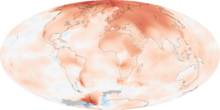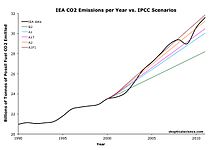Pemanasan global (Inggris: global warming) adalah suatu proses meningkatnya suhu rata-rata atmosfer, laut, dan daratan Bumi.
Suhu rata-rata global pada permukaan Bumi telah meningkat 0.74 ± 0.18 °C (1.33 ± 0.32 °F) selama seratus tahun terakhir. Intergovernmental Panel on Climate Change (IPCC) menyimpulkan bahwa, "sebagian besar peningkatan suhu rata-rata global sejak pertengahan abad ke-20 kemungkinan besar disebabkan oleh meningkatnya konsentrasi gas-gas rumah kaca akibat aktivitas manusia"[1] melalui efek rumah kaca. Kesimpulan dasar ini telah dikemukakan oleh setidaknya 30 badan ilmiah dan akademik, termasuk semua akademi sains nasional dari negara-negara G8. Akan tetapi, masih terdapat beberapa ilmuwan yang tidak setuju dengan beberapa kesimpulan yang dikemukakan IPCC tersebut.
Pemanasan global (Inggris: global warming) adalah suatu proses meningkatnya
Model iklim yang dijadikan acuan oleh projek IPCC menunjukkan suhu permukaan global akan meningkat 1.1 hingga 6.4 °C (2.0 hingga 11.5 °F) antara tahun 1990 dan 2100.[1]
Perbedaan angka perkiraan itu disebabkan oleh penggunaan
skenario-skenario berbeda mengenai emisi gas-gas rumah kaca pada masa
mendatang, serta model-model sensitivitas iklim yang berbeda. Walaupun
sebagian besar penelitian terfokus pada periode hingga 2100, pemanasan
dan kenaikan muka air laut diperkirakan akan terus berlanjut selama
lebih dari seribu tahun walaupun tingkat emisi gas rumah kaca telah
stabil.[1] Ini mencerminkan besarnya kapasitas kalor lautan.
Meningkatnya suhu global diperkirakan akan menyebabkan perubahan-perubahan yang lain seperti naiknya permukaan air laut, meningkatnya intensitas fenomena cuaca yang ekstrem,[2] serta perubahan jumlah dan pola presipitasi. Akibat-akibat pemanasan global yang lain adalah terpengaruhnya hasil pertanian, hilangnya gletser, dan punahnya berbagai jenis hewan.
Beberapa hal yang masih diragukan para ilmuwan adalah mengenai jumlah pemanasan yang diperkirakan akan terjadi pada masa depan, dan bagaimana pemanasan serta perubahan-perubahan yang terjadi tersebut akan bervariasi dari satu daerah ke daerah yang lain. Hingga saat ini masih terjadi perdebatan politik dan publik di dunia mengenai apa, jika ada, tindakan yang harus dilakukan untuk mengurangi atau membalikkan pemanasan lebih lanjut atau untuk beradaptasi terhadap konsekuensi-konsekuensi yang ada. Sebagian besar pemerintahan negara-negara di dunia telah menandatangani dan meratifikasi Protokol Kyoto, yang mengarah pada pengurangan emisi gas-gas rumah kaca.
Global warming is the rise in the average temperature of
Earth's atmosphere and oceans since the late 19th century and its
projected continuation. Since the early 20th century, Earth's mean
surface temperature has increased by about 0.8 °C (1.4 °F), with about two-thirds of the increase occurring since 1980.[2] Warming of the climate system is unequivocal, and scientists are more than 90% certain that it is primarily caused by increasing concentrations of greenhouse gases produced by human activities such as the burning of fossil fuels and deforestation.[3][4][5][6] These findings are recognized by the national science academies of all major industrialized nations.[7][A]
Climate model projections were summarized in the 2007 Fourth Assessment Report (AR4) by the Intergovernmental Panel on Climate Change (IPCC). They indicated that during the 21st century the global surface temperature is likely to rise a further 1.1 to 2.9 °C (2 to 5.2 °F) for their lowest emissions scenario and 2.4 to 6.4 °C (4.3 to 11.5 °F) for their highest.[8] The ranges of these estimates arise from the use of models with differing sensitivity to greenhouse gas concentrations.[9][10]
Future warming and related changes will vary from region to region around the globe.[11] The effects of an increase in global temperature include a rise in sea levels and a change in the amount and pattern of precipitation, as well a probable expansion of subtropical deserts.[12] Warming is expected to be strongest in the Arctic and would be associated with the continuing retreat of glaciers, permafrost and sea ice. Other likely effects of the warming include a more frequent occurrence of extreme-weather events including heat waves, droughts and heavy rainfall, ocean acidification and species extinctions due to shifting temperature regimes. Effects significant to humans include the threat to food security from decreasing crop yields and the loss of habitat from inundation.[13][14]
Proposed policy responses to global warming include mitigation by emissions reduction, adaptation to its effects, and possible future geoengineering. Most countries are parties to the United Nations Framework Convention on Climate Change (UNFCCC),[15] whose ultimate objective is to prevent dangerous anthropogenic (i.e., human-induced) climate change.[16] Parties to the UNFCCC have adopted a range of policies designed to reduce greenhouse gas emissions[17]:10[18][19][20]:9 and to assist in adaptation to global warming.[17]:13[20]:10[21][22] Parties to the UNFCCC have agreed that deep cuts in emissions are required,[23] and that future global warming should be limited to below 2.0 °C (3.6 °F) relative to the pre-industrial level.[23][B] Reports published in 2011 by the United Nations Environment Programme[24] and the International Energy Agency[25] suggest that efforts as of the early 21st century to reduce emissions may be inadequate to meet the UNFCCC's 2 °C target.
Suhu rata-rata global pada permukaan Bumi telah meningkat 0.74 ± 0.18 °C (1.33 ± 0.32 °F) selama seratus tahun terakhir. Intergovernmental Panel on Climate Change (IPCC) menyimpulkan bahwa, "sebagian besar peningkatan suhu rata-rata global sejak pertengahan abad ke-20 kemungkinan besar disebabkan oleh meningkatnya konsentrasi gas-gas rumah kaca akibat aktivitas manusia"[1] melalui efek rumah kaca. Kesimpulan dasar ini telah dikemukakan oleh setidaknya 30 badan ilmiah dan akademik, termasuk semua akademi sains nasional dari negara-negara G8. Akan tetapi, masih terdapat beberapa ilmuwan yang tidak setuju dengan beberapa kesimpulan yang dikemukakan IPCC tersebut.
Meningkatnya suhu global diperkirakan akan menyebabkan perubahan-perubahan yang lain seperti naiknya permukaan air laut, meningkatnya intensitas fenomena cuaca yang ekstrem,[2] serta perubahan jumlah dan pola presipitasi. Akibat-akibat pemanasan global yang lain adalah terpengaruhnya hasil pertanian, hilangnya gletser, dan punahnya berbagai jenis hewan.
Beberapa hal yang masih diragukan para ilmuwan adalah mengenai jumlah pemanasan yang diperkirakan akan terjadi pada masa depan, dan bagaimana pemanasan serta perubahan-perubahan yang terjadi tersebut akan bervariasi dari satu daerah ke daerah yang lain. Hingga saat ini masih terjadi perdebatan politik dan publik di dunia mengenai apa, jika ada, tindakan yang harus dilakukan untuk mengurangi atau membalikkan pemanasan lebih lanjut atau untuk beradaptasi terhadap konsekuensi-konsekuensi yang ada. Sebagian besar pemerintahan negara-negara di dunia telah menandatangani dan meratifikasi Protokol Kyoto, yang mengarah pada pengurangan emisi gas-gas rumah kaca.
This article is about the current change in Earth's climate. For general discussion of how the climate can change, see Climate change. For other uses, see Global warming (disambiguation).
Global mean land-ocean
temperature change from 1880–2012, relative to the 1951–1980 mean. The
black line is the annual mean and the red line is the 5-year running mean. The green bars show uncertainty estimates. Source: NASA GISS.
The map shows the 10-year
average (2000–2009) global mean temperature anomaly relative to the
1951–1980 mean. The largest temperature increases are in the Arctic and
the Antarctic Peninsula. Source: NASA Earth Observatory[1]
Fossil fuel related CO2 emissions compared to five of the IPCC's "SRES" emissions scenarios. The dips are related to global recessions. Image source: Skeptical Science.
Climate model projections were summarized in the 2007 Fourth Assessment Report (AR4) by the Intergovernmental Panel on Climate Change (IPCC). They indicated that during the 21st century the global surface temperature is likely to rise a further 1.1 to 2.9 °C (2 to 5.2 °F) for their lowest emissions scenario and 2.4 to 6.4 °C (4.3 to 11.5 °F) for their highest.[8] The ranges of these estimates arise from the use of models with differing sensitivity to greenhouse gas concentrations.[9][10]
Future warming and related changes will vary from region to region around the globe.[11] The effects of an increase in global temperature include a rise in sea levels and a change in the amount and pattern of precipitation, as well a probable expansion of subtropical deserts.[12] Warming is expected to be strongest in the Arctic and would be associated with the continuing retreat of glaciers, permafrost and sea ice. Other likely effects of the warming include a more frequent occurrence of extreme-weather events including heat waves, droughts and heavy rainfall, ocean acidification and species extinctions due to shifting temperature regimes. Effects significant to humans include the threat to food security from decreasing crop yields and the loss of habitat from inundation.[13][14]
Proposed policy responses to global warming include mitigation by emissions reduction, adaptation to its effects, and possible future geoengineering. Most countries are parties to the United Nations Framework Convention on Climate Change (UNFCCC),[15] whose ultimate objective is to prevent dangerous anthropogenic (i.e., human-induced) climate change.[16] Parties to the UNFCCC have adopted a range of policies designed to reduce greenhouse gas emissions[17]:10[18][19][20]:9 and to assist in adaptation to global warming.[17]:13[20]:10[21][22] Parties to the UNFCCC have agreed that deep cuts in emissions are required,[23] and that future global warming should be limited to below 2.0 °C (3.6 °F) relative to the pre-industrial level.[23][B] Reports published in 2011 by the United Nations Environment Programme[24] and the International Energy Agency[25] suggest that efforts as of the early 21st century to reduce emissions may be inadequate to meet the UNFCCC's 2 °C target.




Tidak ada komentar:
Posting Komentar